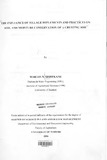The influence of tillage implements and practices on soil and moisture conservation of a crusting soil

View/
Date
2006Author
Sishekanu, Martin N
Type
ThesisLanguage
enMetadata
Show full item recordAbstract
Soil crusting and hard-setting conditions limit agricultural productivity of most semi-arid lands of
Kenya. Hydrological conditions of these soils are negatively influenced by the development and
occurrence of soil crusting and hard-setting under the influence of bad tillage implement practices
and adverse seasonal rainfall characteristics. The occurrence of soil crusting and hard-setting
conditions decrease rainwater infiltration and inversely increases the surface runoff The reduced
rainwater infiltration and high surface runoff induces agricultural soil drought due to reduced
water transmittance and consequent storage into the soil profile. The objectives of this study was
to investigate the influence of tillage implements and practices on soil and moisture conservation
on a crusting and hard-setting (sandy clay loam) Luvisol. This study investigated the hydrological
effects of two tillage implement practices with and without farmyard manure on soil erosion and
moisture conservation on a crusting and hard-setting (sandy clay loam) Luvisol of the semi-arid
Kenya. The experiment was conducted under extreme field conditions of bare land (no test crop)
to eliminate any influence of crop cover, over the pertinent hydrological and soil properties. This
study took two rainy seasons (short and long rains) with field investigations covering rainfall
characteristics, soil surface roughness, shear strength, penetration resistance, bulk density, soil
loss, wet soil aggregate stability, surface runoff and soil moisture. Investigations were conducted
on 12 micro-plots of two square metres laid-out in a Split-plot in a Randomised Complete Block
Design, complemented by a differential tillage depth treatment laid on a Randomised Complete
Block Design. The main experimental treatments consisted of farmyard manure (FYM) at 0 and
10 tonnes per hectare for soil amendment. In the 10 (10) farmyard manure per hectare were
applied through out for soil amendment. The experimental treatments were two tillage implement
practices (minimum tillage -Modified Reversible Maresha Prototype-MRMP, and conventional
Rumptstard -RS) and two farmyard manure applications - FYM (0 and10 tonnes ha"]. A
complementary tillage depth treatment was introduced during the long rainy season aimed at
providing understanding of the effect of tillage depth on soil moisture conservation. The
conventional tillage implement was used at 12 em and 17 em tillage depth with 10 tonnes per
hectare uniform manure application
The tillage implement practices and manure showed a significant influence on surface runoff:
infiltration, soil loss and moisture conservation The hydrological response of all treatments were
influencedby soil crusting and hard-setting. The seasonal rainfall characteristics (amounts, frequency,
durationand intensities) and the treatment effects on the soil surface roughness and aggregate stability
impactedon the hydrological response. The minimum tillage implement practice reduced soil loss by
19'>10, surface runoff by 40% and enhanced water infiltration through out the study period. During the
second rainy season the minimum tillage steadily enhanced soil moisture conservation due to the
furrow depression storage created by the oriented surface roughness of the MRMP. The conventional
tillage implement practice initially reduced soil loss, surface runoff and enhanced water infiltration
From mid rainy season however, soil crusting increased soil loss, surface runoff and reduced water
infihration The treatment response to ten tonnes of manure reduced soil loss by 40010, surface runoff
by 39'>10 and enhanced water infiltration through out the study period. The tillage implement practice
and manureinteraction treatment reduced soil loss by 48%, surface runoff by 68% in the MM and 18%
in the RS and enhanced water-infiltration through out the study period. The soil moisture conservation
response to ten tonnes of manure reduced soil loss by 40010, surface runoff by 39% and enhanced water
infiltrationthrough out the study period.
This study has shown that minimum tillage practice and manure application have a greater impact on
soil loss, surface runoff and soil moisture conservation in a crusting and hard-setting soils of the semiarid.
Rainfall intensities of above 75mm per hour has show to influence total soil loss of 66% and runoff
water of 40010
During the second rainy season the minimum tillage steadily enhanced soil moisture conservation due
to the furrow depression storage created by the oriented surface roughness of the MM
The results obtained showed some significant changes in the hydrological related properties and
soil management treatments. The tillage oriented surface roughness, soil aggregation, soil and
runoff losses and moisture; changed with rainfall events and soil management practices. FYM and
MRMP tillage practices compared to their control of no-manure and RS reduced runoff by 39ll1o
and 40% and soil loss by 40% and 36% respectively. Soil moisture conservation was however,
not improved until about mid-season (short-rains). Deep tillage (RS17) on the other hand showed
a 60% improvement at a 17 em soil depth over the 12 em tillage depth (RS12) and was highly
significantat 5% probability level.
This study has shown that tillage implement (MRMP) practice and incorporation of farm yard
manure (FYM) on a crusting and hard-setting soil is a potential soil and water conservation tool
.that provides protection even when erosive forces are severe. It has also revealed that,
application of un-decomposed manure and MRMP; do not immediately improve moisture
retention. Deep tillage that incorporates FYM beyond 12 em depth can enhance improvement in
soil moisture conservation.
Citation
MASTER OF SCIENCE IN LAND AND WATER MANAGEMENTPublisher
University of Nairobi Department of Environmental and Biosystems Engineering
